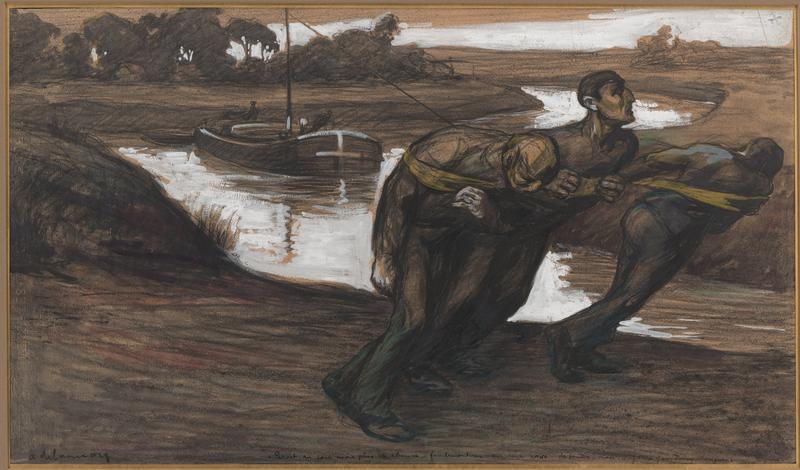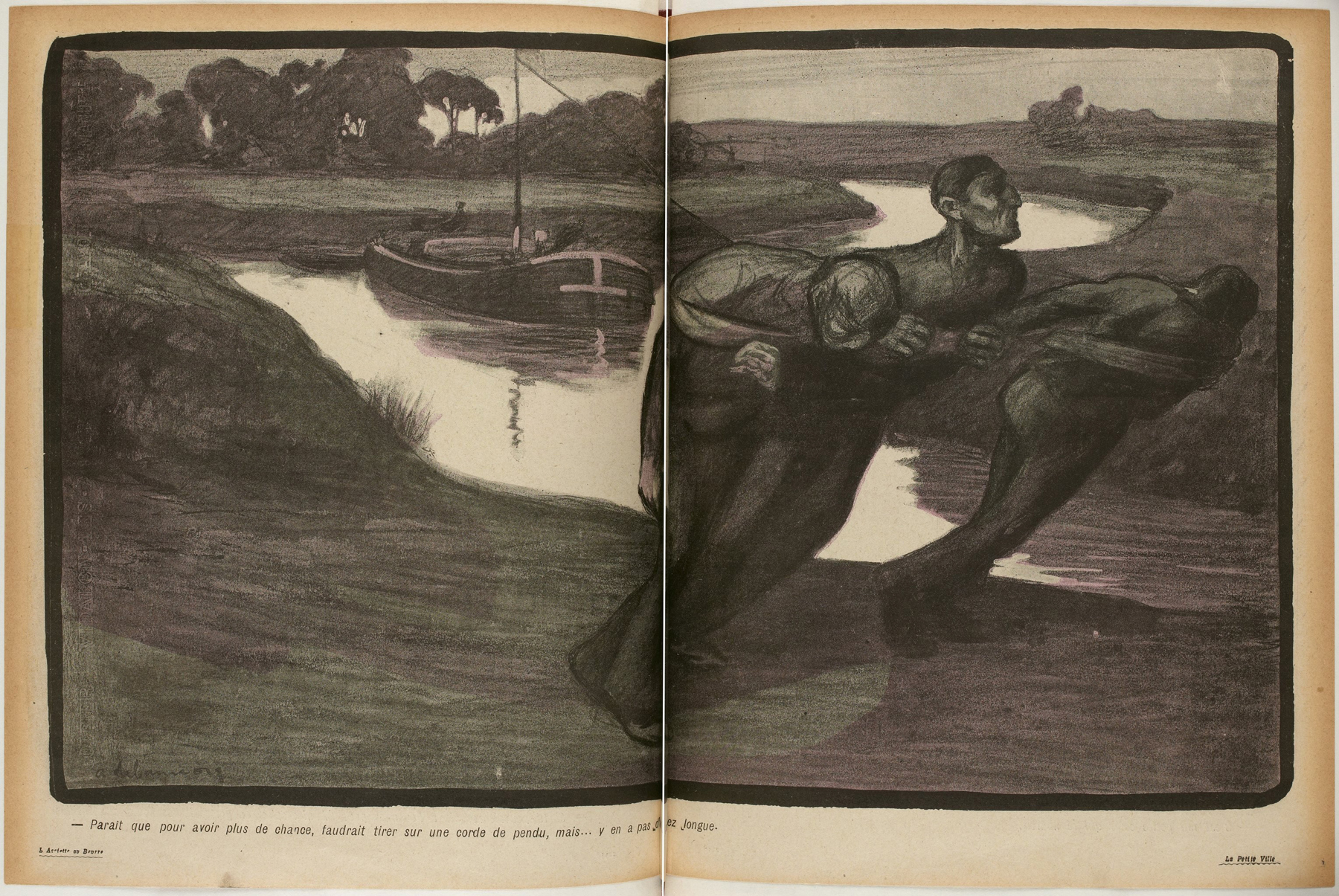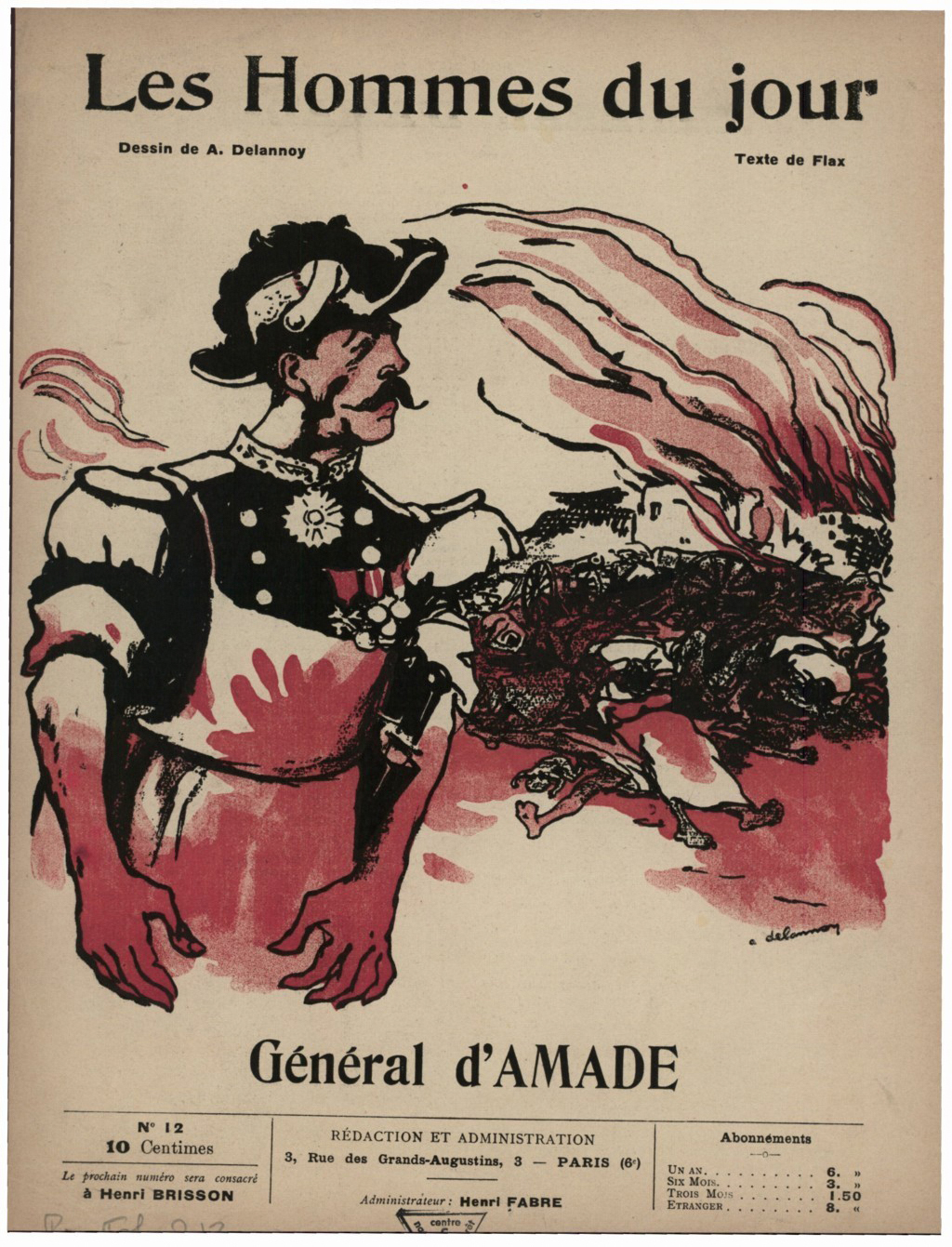
65. Aristide Delannoy, Barge Haulers
| Artist | Aristide Delannoy, French, Béthune 1874–Paris 1911 |
| Title, Date | Barge Haulers (Les hâleurs), c. 1902–3 |
| Medium | Black chalk, watercolor, and gouache |
| Dimensions | 14 3/16 × 24 3/8 in. (36 × 62 cm) |
| Inscriptions + Marks | Lower left: A Delannoy |
| Provenance | [Mathieu Néouze, Paris, until 2014; to Weisberg]; Yvonne and Gabriel Weisberg, Minneapolis |
| Exhibition History | "Reflections on Reality: Drawings and Paintings from the Weisberg Collection," Mia, 2022–23 |
| References | Reproduced in "L’Assiette au Beurre," no. 134 (October 24, 1903), pp. 2256–57, with inscription: Parait que pour avoir plus de chance, faudrait tirer sur une corde de pendu, mais . . . y en a pas d’assez longue. [It is said that to have more luck, one should pull on the rope of a hanged man, but . . . there isn’t one that is long enough.] |
| Credit Line | Promised gift of Gabriel P. and Yvonne M.L. Weisberg, Minneapolis |
Aristide Delannoy grew up in Béthune, France, a mining town about twenty miles southwest of Lille. He attended art school in Lille and continued his studies in Paris but soon found himself unable to support his family as a painter. So he turned to magazine illustration. He became a popular contributor to such left-leaning journals as L’Assiette au Beurre,1 Les Temps Nouveaux, La Guerre Sociale, and Les Hommes du Jour.2
In 1902 L’Assiette au Beurre devoted an entire issue (July 5) to Delannoy’s drawings of small-town life in which he emphasized changes wrought by industrialization. The issue was titled “Au pays noir” (in the black country), a reference to the coal-mining region of southern Belgium and northern France, the area of Delannoy’s childhood. The subtitle was “Notre dame de l’usine” (our lady of the factory). Some images satirized clerics, middle-class values, and moneyed fat cats; others cast light on the plight of workers and their families.

Well aware of Delannoy’s power, the publishers of L’Assiette au Beurre devoted a second issue to his illustrations, this one dated October 24, 1903. The Weisberg drawing appeared in this issue, in a double-page spread (fig. 1). The scene shows three men straining to pull a barge along a waterway. The figures’ postures, the starkness of their forms against the reflections, and the sense that the haulers will walk right off the page produce a powerful sense of their exertion.
The inscription had not yet been added when the drawing was readied for publication. In the magazine, it appeared as a caption:
Parait que pour avoir plus de chance, faudrait tirer sur une corde de pendu, mais. . . y en a pas d’assez longue. (It is said that to have more luck, one should pull on the rope of a hanged man, but . . . there isn’t one that is long enough.)
The first part is a proverb referring to superstitions common in ancient Rome. It is double edged in that one can be lucky, but this luck may necessitate touching something very dark—say, the rope of a hanged man. This concept applies to the businesspeople in Delannoy’s other illustrations, where he depicted them conspiring to manipulate share prices and disregarding the safety and welfare of workers. The last part of the inscription refers to the men hauling the barge, for they have no luck at all. Yet Delannoy seems to imply that together they do have power, just as workers united could change their lot in life.

As Delannoy’s career progressed, his overt satires became ever-sharper thorns in the side of the French government. In 1908 the cover of Les Hommes du Jour featured Delannoy’s drawing of Prime Minister Georges Clemenceau, his head turned into a skull on a stick. Later that year, the journal devoted its cover to Delannoy’s depiction of General Albert d’Amade—who led the military in asserting French claims in Morocco—wearing a bloody butcher’s apron (fig. 2). For his impertinence, Delannoy was sentenced to a year in the notorious La Santé prison and fined 3,000 francs, then a considerable sum. Other artists rallied to his cause. The May 8, 1909, issue of L’Assiette au Beurre was dedicated to him; the theme was artists’ rights and their role in society. Artists contributed their illustrations without charge, and the original drawings were offered for sale to support Delannoy’s family. A month later, he was released early on the grounds of ill health. He died from tuberculosis less than two years later. The incident made other satirists take note, and many no longer dared to sign their real names to their work.
GPW and TER
Notes
L’Assiette au Beurre was an illustrated French weekly satirical magazine produced between 1901 and 1912. The content focused on socialist and anarchist ideas. Beyond Delannoy, artists such as Félix Vallotton, Théophile Alexandre Steinlen, Henri Gustave Jossot, Jean Louis Forain, Leonetto Cappiello, and Henri Gabriel Ibels published images in the magazine, and writers such as Anatole France and Octave Mirbeau contributed articles. Delannoy was implicated by the government several times because of his left-leaning ideas. ↩︎
The full extent of Delannoy’s published oeuvre remains to be studied. ↩︎